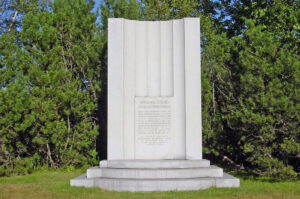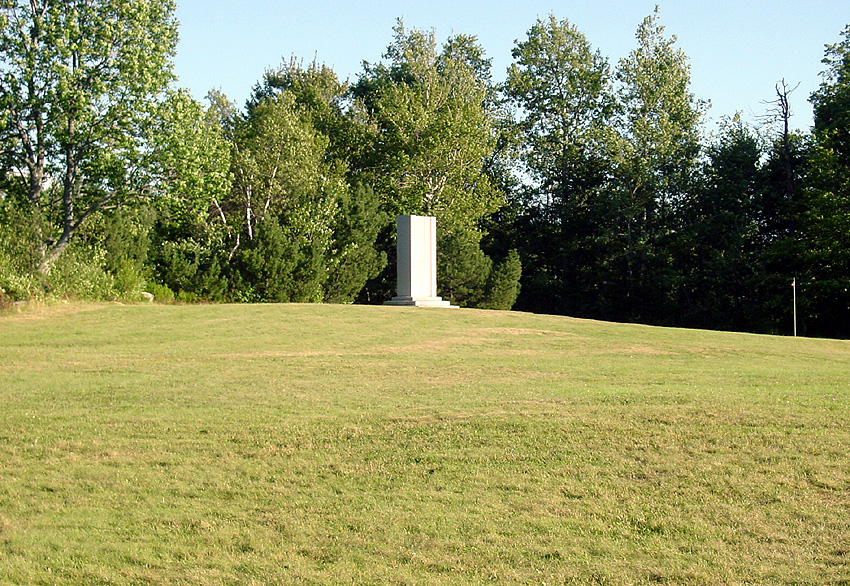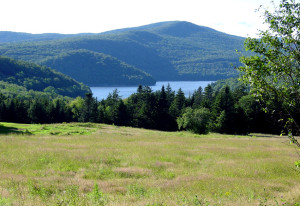Brigham Young Birthplace & Monument - Whitingham, Vermont

Brigham Young, second President and Prophet of The Church of Jesus Christ of Latter-day Saints was born in Whitingham, Vermont on June 1, 1801, the ninth child born to John and Abigail Young.
President Young was a leader, colonizer, and pioneer. The mantle of the leadership of the Church fell on him after Joseph and Hyrum Smith were martyred at Carthage Jail. He led the Saints to the Salt Lake Valley where they made the desert “blossom like a rose.”1 Near the end of his life, Brigham Young spoke of the results of his own labors as follows:
“The peopling of this Territory by the Latter-day Saints of about 100,000 souls; the founding of over 200 cities, towns and villages inhabited by our people, which extend to Idaho in the north, Wyoming in the east, Nevada in the west, and Arizona in the south, and the establishment of schools, factories, mills and other institutions calculated to improve and benefit our community.
All my transactions and labors have been carried on in accordance with my calling as a servant of God. I know no difference between spiritual and temporal labors. God has seen fit to bless me with means, and as a faithful steward I use them to benefit my fellowmen-to promote their happiness in this world in preparing them for the great hereafter.
My whole life is devoted to the Almighty’s service, and while I regret that my mission is not better understood by the world, the time will come when I will be understood, and I leave to futurity the judgment of my labors and their result as they shall become manifest.” 2
In 1950 a memorial was erected to commemorate his birthplace with President George Albert Smith dedicating the monument. At the unveiling, Judge Harrie B. Chase of the United States Court of Appeals representing the Whitingham township remarked, “The name Brigham Young has become accepted as a symbol of perseverance, courage to bear difficulties, and capacity to surmount them. This monument is a fitting tribute to a great American, Whitingham’s famous son.”3

SOURCES
1 Isaiah 35:1.
2 Preston Nibley, Brigham Young: The Man and His Work, 4th ed. (Salt Lake City: Deseret Book Co., 1960, 492.
3 Clarence S. Barker, “From the Green Hills To Statuary Hall,” Improvement Era, Volume 53, No. 8, (August 1950).
Map & Directions
Hours of Operation: Daylight to Dark
Admission: Free
Ownership Status
The large monument is located just beyond left field line of a softball field at the Old Whitingham Center. It is open to the public at no charge. The smaller marker is in the front yard of a private residence but it can be viewed from the public street (Brigham Young Hill, also known as Stimpson Hill).
Photos



Articles & Resources
President George Albert Smith's Remarks at the Unveiling Ceremony of the Brigham Young Monument
Author(s): George Albert Smith
Type: First-person account
Source(s): “Brigham Young — a Great Man”, Improvement Era, 1950, Vol. 53. July, 1950. No. 7.
“Brethren and sisters, and fellow Vermonters. My folk came from Vermont, too, and I am glad to come back to this state that has produced so many unusual and outstanding men and women. I have in my hand a list of more than a hundred names of men and women, mostly men, who as pioneers left this wonderful green country and went out into the desert to make their home. The result was that I was fortunate enough to be born out there in Utah.
There is much that has been said already about President Brigham Young, and much more that could be said, and I would like to suggest to you members of the Church of Jesus Christ of Latter-day Saints who are here, that until you have read the history of President Brigham Young, you have failed to observe much worth-while information that you might find in his life.
Reference has been made to the fact that Joseph Smith was born in Vermont. The Quakers came into Massachusetts near Topsfield where the Prophet’s forebears were living. It was contrary to the law to feed or entertain the Quakers in those days. Two of them came to the house of Samuel Smith and said, ‘We can’t get anything to eat and have no place to rest. Will you tell us what to do?’
Samuel Smith invited them in. He gave them a place to stay for the night and sent them on their way the next morning, fed and rested. When his neighbors learned what he had done, he was arrested and taken into court where he was sentenced to pay a fine and was imprisoned for entertaining Quakers. That was a forebear of Joseph Smith.
The result was that when Samuel Smith was released from jail, he called his neighbors together and said, “My property is for sale.”
‘What do you mean?’ they asked. ‘You have a nice place, why are you selling?’
He replied, ‘I am going away from here. I will no longer live as a member of a community that would put one of God’s sons in prison for entertaining others of his sons when they were in distress. I am going to leave you.’
They pleaded with him and told him that he knew before he took the Quakers in, what the penalty was.
He said, ‘Yes, I knew, and I expected to pay a fine, but I didn’t think that my own neighbors would consent to putting me in jail.’ He sold his property and moved to Vermont and, as a result, it was the birth-place of the Prophet Joseph Smith, and that circumstance has added his illustrious name to the list of other famous people from this state of Vermont.
I was personally acquainted with Brigham Young. I think if I were to tell you of my first introduction to him, you might be interested. I was a little boy, five years of age. I had a black velvet suit, and my hair was nearly as white then as it is now, and I had hair in those days, too. My mother called me in to the house one day and dressed me in my new black velvet suit and put a letter in my pocket. I can see the picture of it now in my mind’s eye. My mother told me to go up to President Young’s office and ask to see him and give the letter to him and to no one else.
I went up to his home. At that time he lived in what today would be considered a fortress. The Indians were at times troublesome and for safety, the block where President Young lived was surrounded by a strong wall as high as this monument.
I had two long blocks to walk from my house to Brigham Young’s. Mother had told me how to get there. When I arrived at the gate, I discovered that it was partly open. It was a large, heavy gate made of two-by-four timbers and fastened by great heavy iron hinges. It took quite a push to open it, it was so heavy, and when it was closed and barred on the inside with timbers that were dropped down into position, it couldn’t be opened from without. As I looked inside the gate a large Scotchman by the name of John Smith looked at me and said, ‘What do you want?’ He scared me nearly to death. I told him that I wanted to see Brigham Young, and he said, ‘President Young has no time for the likes of ye.’ He bellowed so that I was nearly ready to faint. But then I looked at the open door of the office and a great big man, nearly six feet tall and with a long white beard and hair, was standing in the doorway and he called to the guard and said, ‘What’s wanted, John?’
John replied, ‘Here is a little fellow wants to see President Young,’ and then he roared with laughter. He thought it was a good joke. But with all the dignity in the world, President Young said to him, ‘John, show him in.’
There was nothing else the guard could do then but to let me in and he took me up to the porch where President Young was standing, for it was the President himself.
President Young took me by the hand and led me into his office, sat down at his desk and lifted me up on his knee and put his arm around me. In the kindest way one could imagine, he said, ‘What do you want of President Young?’
Just think of it! He was President of a great Church and Governor of a Territory, and with all the duties he had to perform, yet I as a little boy was received with as much dignity and kindness as if I had come as a governor from an adjoining state.
I felt in my pocket, took out the envelope, and said, ‘My mother told me to give this to you.’
My father was on a mission in England at that time and that gave my mother and her family some privileges. President Young was president of the railroad that ran between Salt Lake City and Ogden. The letter read, ‘Dear President Young: I haven’t seen my father and mother for some time. I would like to take my family to Ogden to visit with them. I would appreciate it if you would arrange it so I could go.’
President Young took a little bell and rang it, and in came one of his secretaries. He handed the letter to the secretary and told him to fulfil the request and bring it back to him. The secretary made out a pass for us to Ogden and return and gave it to President Young, who took a quill pen and signed his name to it. He then took the same envelope that it came in and put the pass in it. (Take note of the fact that he didn’t use a new envelope but used the old one.) He then tucked the envelope in my pocket.
While we were waiting for the pass, he had been telling me what a wonderful father and mother I had and what a good boy I ought to be because of them. He walked to the door with me, and as I left, he said, ‘When you reach home, tell your mother that I hope she and her family will have a pleasant time with her family in Ogden.’
I went my way and gave Mother the envelope and the pass and we all went to Ogden to visit another Vermonter, my grandfather, Lorin Farr, who came from Vermont. He was the first mayor of Ogden, Utah, for twenty years served the legislature from that district, built the first sawmill, the first gristmill, and the only woolen mill they have had. He was one of the contractors who built the Central Pacific Railroad from the West to where it joined with the Union Pacific at Promontory, Utah, where the gold spike was driven. He was a true Vermonter. He was a hard worker, and his family, both boys and girls, were taught to work, and I have always considered him a great man.
Do you wonder then, that I am glad to be here today when this monument that is placed here at his birthplace is to be dedicated? I am glad to be with the rest of you and I would like to say that I appreciate the opportunity of being here with you in this glorious sunshine with this beautiful and delightful atmosphere, and to be here with these prominent people from different parts of the country. There would have been many others here if they had been in a position to come, but I am glad to be present. As I look at this lovely monument, I am wondering what President Young would say if he were here. Of course, there are other monuments to him, but this is at his birthplace and where he ought to have a monument.”
Dedicatory Prayer of the Brigham Young Monument offered by President George Albert Smith
Author(s): George Albert Smith
Type: Dedicatory Prayer
Source(s): Improvement Era, 1950, Vol. 53. September, 1950. No. 9.
“Our Father who art in heaven, hallowed be thy name, thy kingdom come, thy will be done, in earth as it is in heaven: We, thy children, have met together on this spot in this wonderful part of the great United States of America. We are here to do honor to one of thy faithful sons who in the past so lived that there are hundreds of thousands of people who honor him and revere his memory.
We are here now to present this monument of granite, the native granite of this great state, that which President Brigham Young himself undoubtedly would choose if he were here, and, Heavenly Father, we pray that thy Spirit may remain here that those who come to read the inscription on the monument may realize that thou art the Father of us all and that he whom we are gathered to honor was one of thy choice sons who was great enough to assume his responsibilities and carry a tremendous load during his long lifetime.
Heavenly Father, we thank thee for our citizenship in this great land. We thank thee for America; we thank thee for this great state of Vermont and the men and women who have represented it down through the last one hundred and fifty years or more. We are grateful for the boys and girls growing up in this state. Father, bless them that they may have a desire to do the things that thou wouldst have them do, so they may grow to be what thou wouldst have them to be, and when the time comes that thou shalt make thy residence here on this earth, when it shall be the celestial kingdom, grant that all those growing up now will have so lived together with those who have passed on, that their names may all be recorded in the Lamb’s book of life, entitling them to an inheritance here in thy celestial kingdom.
Heavenly Father, we pray that thy Spirit may go with us. Bless us as we go from here that we may feel grateful for all thy mercies extended to us, and wilt thou accept of this offering which we have prepared in memory of thy great son.
We ask that thou wilt accept it as an offering from those who love him and appreciate his many virtues. Grant that it may be preserved from the elements, that it may stand here, and that all who come here may feel the kindness of thy presence, Heavenly Father, and enjoy thy Spirit and go forward with renewed determination to be what thou wouldst have them be. To this end and in the authority of the Holy Priesthood, we dedicate this monument to the memory of Brigham Young and pray that thou wilt accept this dedication, Heavenly Father, and fulfil our desires regarding it, and this we do in the name of Jesus Christ, our Lord. Amen.”
Additional Reading Resources
Larry C. Porter, “Brigham Young’s Birthplace in Whitingham, Vermont,” Regional Studies in Latter-day Saint Church History: New England, ed. Donald Q. Cannon, 1988.
Larry C. Porter, “Whitingham, Vermont: Birthplace of Brigham Young – Prophet, Colonizer, Statesman,” Lion of the Lord, ed. Susan Easton Black and Larry C. Porter, 1995.
A. Gary Anderson, et al., in LaMar C. Berrett, ed., Sacred Places Vol 1, 89-92.
